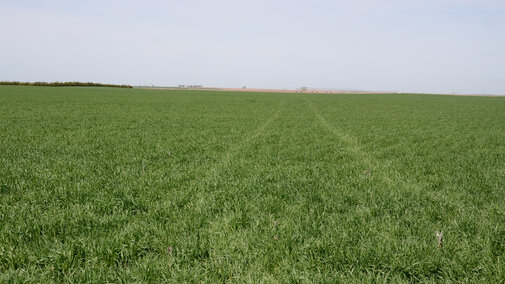For information on specific diseases, see Disease Management in Wheat in CropWatch.
This fall a number of diseases have been observed in winter wheat. All three rust diseases — leaf, stem, and stripe — were observed, but stripe rust was the most prevalent and severe due to favorable temperatures. Wheat streak mosaic virus also was observed at severe levels in a couple fields in Cheyenne County where volunteer wheat was not controlled. Given these observations and depending on the weather next spring, we are likely to see significant levels of disease during the 2017 growing season.
Below are some tips for managing wheat diseases in 2017, beginning with steps you can take now.
In Winter
Put together a comprehensive disease management program. Key steps in such a program include:
- Identify primary diseases
- List available management tactics
- Develop criteria for selection of management tactics
- Establish scouting guidelines and a management plan for each disease
- Choose the best combination of management tactics
- Implement the management tactics chosen
In Spring
- Start scouting early to determine if stripe rust overwintered. Detection of stripe rust early in the spring on the lower leaves is an indication that it overwintered. In this case, it will be advisable to apply an early, preventive fungicide spray at the early jointing growth stage (around Feekes 6).
- Monitor the weather. If cool, wet conditions are forecast, a second spray at 50%-100% flag leaf emergence to protect the flag leaf from stripe rust and other fungal diseases (leaf rust and fungal leaf spot diseases) will be necessary. In the scab-prone regions of the state (southeast, south central, and southwest), if there is abundant rainfall starting three weeks before flowering and into the flowering period, the risk for scab (Fusarium head blight) will be elevated. If these conditions occur, be prepared to apply a scab fungicide (Prosaro or Caramba) during the period from flowering to about one week later (a wider window of application than previously recommended).
- Monitor reports of rust in southern states. If there are significant levels of rust in Oklahoma and Kansas wheat fields, the chances are high that Nebraska fields will have similar levels of rust. Monitoring these reports will help you get prepared.
In Summer and Fall
- Control volunteer wheat after harvest to reduce over-summering of virus diseases such as wheat streak mosaic and fungal diseases such as stripe rust and leaf rust.
- Choose the varieties to plant in the fall based on agronomic performance and disease resistance.
- Treat seed with a fungicide before planting. This will protect the crop from seed-transmitted diseases such as common bunt, loose smut, and flag smut.
- Avoid early planting. Damage from fall season diseases such as wheat streak mosaic, barley yellow dwarf, and stripe and leaf rust is greater the earlier wheat is planted.
- Control volunteer wheat after harvest to reduce over-summering of virus diseases such as wheat streak mosaic and fungal diseases such as stripe rust and leaf rust.
- Choose the varieties to plant in the fall based on agronomic performance and disease resistance.
- Treat seed with a fungicide before planting. This will protect the crop from seed-transmitted diseases such as common bunt, loose smut, and flag smut.
- Avoid early planting. Damage from fall season diseases such as wheat streak mosaic, barley yellow dwarf, and stripe and leaf rust is greater the earlier wheat is planted.
Stephen Wegulo
Extension Plant Pathologist

